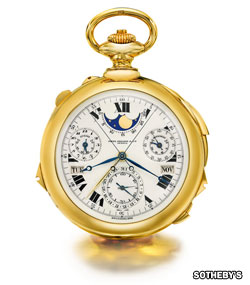
Supercomplication, Patek Philippe, 1932.
As 2014 ticks to a close, we take a look at an absolutely stunning timepiece that last month went to auction at Sotheby’s in Geneva.
With its intricate design and incredible array of features, the Supercomplication is a truly magnificent and beautiful piece of horological engineering.
Sold at Sotheby’s for £13.4m in November 2014, the Henry Graves Supercomplication is a handmade watch commissioned by Graves in 1925. It has now set a record price for any timepiece sold at auction.
Designed and created by Patek Philippe and delivered to Henry Graves in 1933, the Supercomplication has 900 parts and remains the most complicated watch built without the use of computer technology.
In watch-making terms, a “complication” refers to an additional feature which does something other than telling the time. The Supercomplication had 24 additional features including Westminster chimes, a perpetual calendar with phases of the moon, sunrise and sunset times, a celestial map and a split second stopwatch.
Born in New Jersey in 1868, Henry Graves was a sportsman and watch collector with a keen interest in the competitive side of watch-making – especially The Geneva Observatory Timing contest, which pitted timepieces against each other for prizes. As patron of Patek Philippe and in competition with auto engineer James Packard, Graves was keen to commission a timepiece which could rival the 10 complications of the Packard Watch. Created in 1927, the Packard Watch was the first to feature a sky chart – including 500 gold stars to make up a stunning celestial map!
Graves invested 68,000 Swiss Francs (£38,000 at today’s exchange rate) in the Supercomplication. The watch itself took three years to design and another five to manufacture its complex workings.

The Supercomplication’s super-complicated mechanism.
Not only did the Henry Graves Supercomplication surpass the Packard Watch, it utilised some of the most advanced horological techniques and remains the only one of its kind ever made. Apparently, the watch was last wound in 1969 – and it’s still working!
